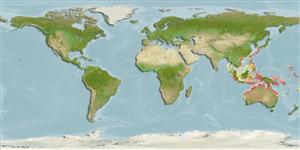>
Acanthuriformes (Surgeonfishes) >
Pomacanthidae (Angelfishes)
Etymology: Chaetodontoplus: Greek, chaite = hair + Greek, odous = teeth + Greek, plous, ous, oo = crossing (Ref. 45335).
Eponymy: Francis Houssemayne du Boulay (1837–1914) was a collector, entomologist and natural history artist, sending specimens to British and Australian museums. [...] (Ref. 128868), visit book page.
More on author: Günther.
Environment: milieu / climate zone / profondeur / distribution range
Écologie
marin récifal; non migrateur; profondeur 5 - 20 m (Ref. 90102). Tropical
Indo-West Pacific: northern Australia and parts of Indonesia, southward to Lord Howe Island.
Taille / Poids / Âge
Maturité: Lm ? range ? - ? cm
Max length : 28.0 cm TL mâle / non sexé; (Ref. 3132)
Épines dorsales (Total) : 11; Rayons mous dorsaux (Total) : 22; Épines anales: 3; Rayons mous anaux: 21.
Body shape (shape guide): short and / or deep; Cross section: compressed.
Inhabits coastal and inner reef areas with rubble, soft bottoms, or open flat bottom areas with rock, coral, sponge, and seawhip outcrops. May be found in small groups (Ref. 9710). Feeds on sponges and tunicates. Forms pairs or small groups. Occasionally exported through the aquarium trade (Ref. 48391).
Life cycle and mating behavior
Maturité | Reproduction | Frai | Œufs | Fécondité | Larves
Randall, J.E., G.R. Allen and R.C. Steene, 1990. Fishes of the Great Barrier Reef and Coral Sea. University of Hawaii Press, Honolulu, Hawaii. 506 p. (Ref. 2334)
Statut dans la liste rouge de l'IUCN (Ref. 130435: Version 2025-1)
Menace pour l'homme
Harmless
Utilisations par l'homme
Pêcheries: commercial; Aquarium: Commercial
Outils
Articles particuliers
Télécharger en XML
Sources Internet
Estimates based on models
Preferred temperature (Réf.
123201): 24.9 - 29.3, mean 28.4 °C (based on 1455 cells).
Phylogenetic diversity index (Réf.
82804): PD
50 = 0.5000 [Uniqueness, from 0.5 = low to 2.0 = high].
Bayesian length-weight: a=0.03090 (0.01378 - 0.06932), b=2.88 (2.69 - 3.07), in cm total length, based on LWR estimates for this (Sub)family-body shape (Ref.
93245).
Niveau trophique (Réf.
69278): 2.7 ±0.00 se; based on food items.
Résilience (Réf.
120179): Milieu, temps minimum de doublement de population : 1,4 à 4,4 années (Preliminary K or Fecundity.).
Fishing Vulnerability (Ref.
59153): Low vulnerability (18 of 100).
🛈
Nutrients (Ref.
124155): Calcium = 54.9 [28.3, 91.2] mg/100g; Iron = 0.562 [0.341, 0.921] mg/100g; Protein = 18.3 [17.1, 19.4] %; Omega3 = 0.0907 [, ] g/100g; Selenium = 26.3 [14.5, 48.1] μg/100g; VitaminA = 70.7 [18.2, 249.4] μg/100g; Zinc = 1.43 [0.99, 2.05] mg/100g (wet weight);
